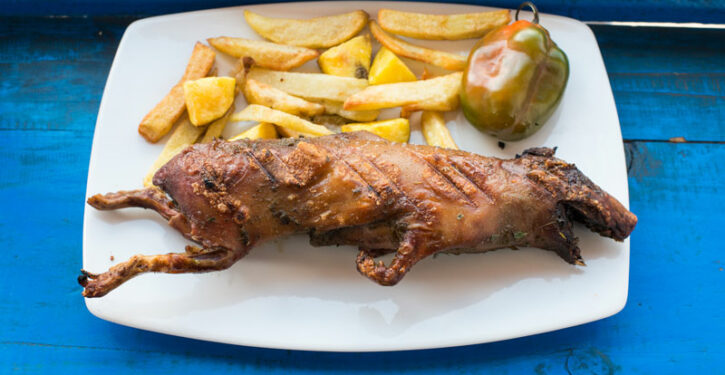
“Purveyors of lab-grown meat — who prefer the term ‘cell-cultivated,’ to avoid the mad-scientist-with-a-test-tube image — foresee a world where our plates are full of steak but animal slaughter is largely a thing of the past,” reports Axios.
Crunchbase reports that investors are pouring more than a billion dollars each year into startups “working on cell-cultured meat and other cell-cultured meat alternatives.”
But “for now, meat grown from animal cells is only available in the U.S. in very limited quantities at two high-end restaurants. Chicken is the first proof-of-concept product, and while the taste is familiar, the texture is a work in progress. It remains to be seen if the technology to ‘grow’ meat at scale will prove economical — and if consumers will welcome the results.”
Some consumers say the artificial chicken is not as juicy or tender as real chicken. Two companies in the San Francisco Bay region — Upside Foods and Good Meat — have gotten regulatory approval to sell their first product, cultivated chicken.
Chef Dominique Crenn is serving Upside’s chicken in a $150 tasting menu in a San Francisco restaurant. Chef José Andrés is serving Good Meat’s chicken at his China Chilcano restaurant in Washington, D.C. His $70 tasting menu includes “Anticuchos de Pollo, cultivated chicken marinated with anticucho sauce, native potatoes and ají amarillo chimichurri.”
The artificial chicken is not available in grocery stores. If you want to buy it in a grocery store, you will have to travel to Singapore. Good Meat’s chicken went on sale in December at Huber’s Butchery there after Singapore became the first nation to approve retail sales of cultivated meat.
As Axios explains,
To manufacture cultivated meat, animal cells are placed in a large steel vessel called a bioreactor — or “cultivator” — and fed for at least two weeks with a variety of nutrients, which help the cells grow and differentiate similarly to how they would in a living animal. Depending on how the cells are nurtured, the product can emerge in the consistency of soup or pancake batter — to be formed into a sausage or nugget — or in a filet-like sliver of meat. “Instead of raising a chicken, we are raising chicken cells, letting the cells do what they naturally do, which is grow,” said Valeti, a cardiologist who founded Upside Foods in 2015. Unlike at a farm, “we don’t have fecal matter; we do not have the skin and the hair and the bones” of the animal. It’s “significantly more efficient than growing an entire animal and eating only a part” of it, he claims.
Winston Churchill predicted in 1931 that within a half century “we shall escape the absurdity of growing a whole chicken in order to eat the breast or wing, by growing these parts separately under a suitable medium.” But it has taken longer than that to produce lab-grown meat.
Lab-grown meat may not be better for the environment. A study concluded that because of the energy consumption needed to scale up cultured meat, its carbon footprint could be several times that of conventional chicken.
If people are concerned about the environment, they should shift to kinds of meat that consume less land mass, such as guinea pigs.
Guinea pigs are a much more efficient source of protein, per acre, than cattle, generating four times as much meat per acre. Guinea pigs also generate less greenhouse gas emissions per pound of meat. So they are an earth-friendly food.
In Peru, guinea pigs are often eaten with potatoes and salsa, or french fries. Guinea pig (called cuy in Peru) has been served whole on special occasions since Inca times.
Eating insects rather than beef or pork reduces greenhouse gas emissions and pollution. As Benjamin Kolb notes at SciDevNet:
Insects caught in the wild are already eaten widely in the developing world. Now a study says that farming them on a large scale for food would damage the environment far less than equivalent livestock production.
Scientists compared emissions, by livestock and by insects, of the greenhouse gases methane and nitrous oxide, which have a greater warming effect than carbon dioxide. They also measured ammonia production, which harms the environment by acidifying soil and water.
They reared mealworms, locusts and crickets, all of which are consumed around the world, as well as sun beetles and cockroaches, which people do not eat, despite their potential as a protein source, while monitoring the amount of gas produced per kilogram of insect growth.
Compared to cattle, weight for weight, insects emitted 80 times less methane — a gas with 25 times more impact on global temperature levels than carbon dioxide.
And crickets produced 8-12 times less ammonia than pigs.



